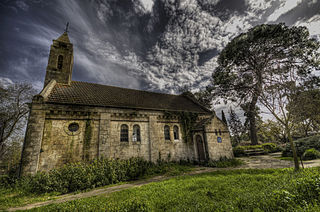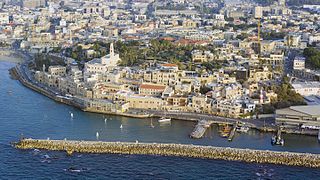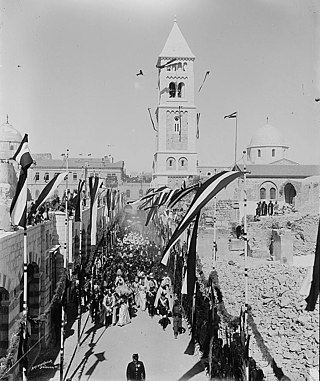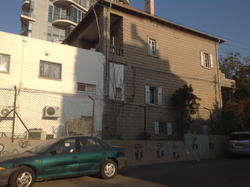
Bethlehem of Galilee or Bethlehem-in-the-Galilee is a moshav in northern Israel. Located in the Galilee near Kiryat Tivon, around 10 kilometres north-west of Nazareth and 30 kilometres east of Haifa, it falls under the jurisdiction of the Jezreel Valley Regional Council. As of 2022 it had a population of 824.

The Yishuv, HaYishuv HaIvri, or HaYishuv HaYehudi Be'Eretz Yisra'el was the community of Jews residing in Palestine prior to the establishment of the State of Israel in 1948. The term came into use in the 1880s, when there were about 25,000 Jews living in that region, and continued to be used until 1948, by which time there were some 630,000 Jews there. The term is still in use to denote the pre-1948 Jewish residents in Palestine, corresponding to the southern part of Ottoman Syria until 1918, OETA South in 1917–1920, and Mandatory Palestine in 1920–1948.

The Atlit detainee camp was a internment camp established by the authorities of Mandatory Palestine in the late 1930s on what is now the Israeli coastal plain, 20 kilometres (12 mi) south of Haifa. Under British rule, it was primarily used to hold Jews and Arabs who were in administrative detention; it largely held Jewish immigrants who did not possess official entry permits. Tens of thousands of Jewish refugees were interned at the camp, which was surrounded by barbed wire and watchtowers.

Tatura is a town in the Goulburn Valley region of Victoria, Australia, and is situated within the City of Greater Shepparton local government area, 167 kilometres (104 mi) north of the state capital (Melbourne) and 18 kilometres (11 mi) west of the regional centre of Shepparton. At the 2021 census, Tatura had a population of 4,955.

The German Templer Society, also known as Templers, is a Radical Pietist group that emerged in Germany during the mid-nineteenth century, the two founders, Christoph Hoffmann and Georg David Hardegg, arriving in Haifa, Palestine, in October 1868 with their families and a few fellow Templers in order to establish a colony. Templer theology is rooted in the legacy of preceding centuries during which various Christian groups undertook to establish the perfect Christian religion in preparation for Christ's promised return. The movement was founded by Christoph Hoffmann, [1815-1885] who believed that humanity's salvation lay in the gathering of God's people in a Christian community. He also believed that the second coming of Christ was imminent, and that according to Biblical prophecy it would take place in Jerusalem, where God's people were to gather as a symbol of the rebuilding of the temple.

Sarona is a neighborhood of Tel Aviv, Israel which started as a German Templer colony in Palestine in 1871. It was one of the earliest modern villages established by Europeans in Ottoman Palestine. In July 1941, the British Mandate authorities deported 188 residents of Sarona, who were considered ardent Nazi sympathizers. By the 2000s, the area had fallen into disrepair and was a haven for drug users. However, since 2003, the area has undergone massive renovation, which involved moving and relocating historical buildings before their restoration. The area is now a popular shopping district, as well as home to museums, cultural artifacts centering on its history, and IDF complexes.

The Cyprus internment camps were camps maintained in Cyprus by the British government for the internment of Jews who had immigrated or attempted to immigrate to Mandatory Palestine in violation of British policy. There were a total of 12 camps, which operated from August 1946 to January 1949, and in total held 53,510 Jews.

The German Colony is an area of Haifa established in 1868 during Ottoman rule as a Christian German Templer Colony in Palestine. It was the first of several colonies established by the group in the Holy Land. Others were founded in Sarona near Jaffa, Galilee and Jerusalem. Some of the original buildings are still surviving today, and the area continues to be visited, lived in, and in use.

Bnei Atarot is a moshav in the Central District of Israel. Located near Yehud, around 15 kilometres east of Tel Aviv, it is situated in fertile plains at the eastern rim of Tel Aviv metropolitan area next to Ben Gurion Airport and falls under the jurisdiction of Hevel Modi'in Regional Council. In 2022 it had a population of 934.

The Jewish insurgency in Mandatory Palestine, known in the United Kingdom as the Palestine Emergency, was a paramilitary campaign carried out by Zionist militias and underground groups—including Haganah, Lehi, and Irgun—against British rule in Mandatory Palestine from 1944 to 1948. The tensions between the Zionist underground and the British mandatory authorities rose from 1938 and intensified with the publication of the White Paper of 1939. The Paper outlined new government policies to place further restrictions on Jewish immigration and land purchases, and declared the intention of giving independence to Palestine, with an Arab majority, within ten years. Though World War II brought relative calm, tensions again escalated into an armed struggle towards the end of the war, when it became clear that the Axis powers were close to defeat.

Wilhelma, originally Wilhelma-Hamîdije, was German Templer Colony in Palestine, located southwest of al-'Abbasiyyah near Jaffa.

Alonei Abba is a moshav shitufi in northern Israel. Located in the Lower Galilee near Bethlehem of Galilee and Alonim, in the hills east of Kiryat Tivon, it falls under the jurisdiction of the Jezreel Valley Regional Council. In 2022 it had a population of 990.

Immanuel Church is a Protestant church in the American–German Colony neighbourhood of Tel Aviv in Israel.

The American–German Colony is a residential neighborhood in the southern part of Tel Aviv, Israel. It is located between Eilat Street and HaRabbi MiBacherach Street and adjoins Neve Tzedek. It was originally established as an American colony, but when that failed, it was resettled and became a German Templer colony, which in time evolved into a mixed German Protestant colony.

Tel Aviv and Jaffa deportation was the expulsion on April 6, 1917, of 10,000 people from Jaffa, including Tel Aviv, by the authorities of the Ottoman Empire in Palestine. The evicted civilians were not allowed to carry off their belongings, and the deportation was accompanied by severe violence, starvation, theft, persecution and abuse. It is thought that about 1,500 of the evicted people died as a result of the deportation. Shortly after the deportation, the Muslims affected were able to return to their homes, but the Jewish population was not able to return until the summer of 1918.

Jaffa, also called Japho, Joppa or Joppe in English, is an ancient Levantine port city which is part of Tel Aviv-Yafo, Israel, located in its southern part. The city sits atop a naturally elevated outcrop on the Mediterranean coastline.

Wilhelm II's voyage to the Levant in 1898 was a state visit that the German Emperor undertook in the Ottoman Empire between 25 October and 12 November 1898.
The German Templer colonies in Palestine were the settlements established in Ottoman Palestine and Mandatory Palestine by the German Pietist Templer movement in the late 19th and early 20th century. During and shortly after World War II, these colonies were depopulated, and its German residents deported to Australia.
On 22 March 1946, Gotthilf Wagner, the leader of the German Templer colonies in Palestine, was assassinated by the Haganah as part of the Jewish Resistance Movement.
The Nazi Party in Mandatory Palestine, also referred as the Nazi Party of Palestine and the Levant was a local branch of the Nazi Party in British-ruled Mandatory Palestine, established by members of the German Templer colonies in Palestine. The branch was established in March 1933 and gradually eradicated during the World War II by the British authorities via deportation of its members and their families. Some of the party members enlisted into the Nazi German military and participated in operations on behalf of the axis powers, notoriously including Operation Atlas targeting Mandatory Palestine.

















